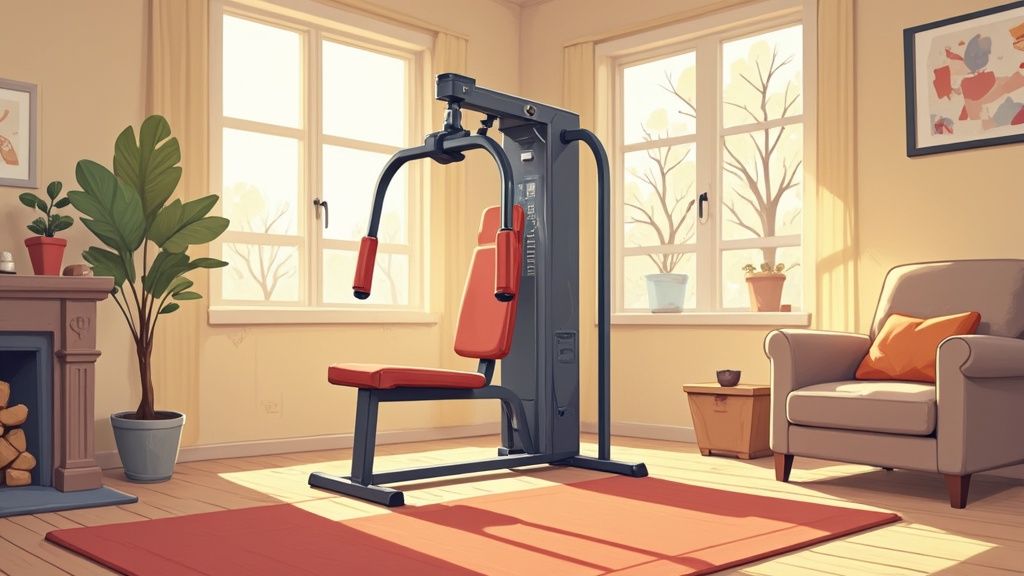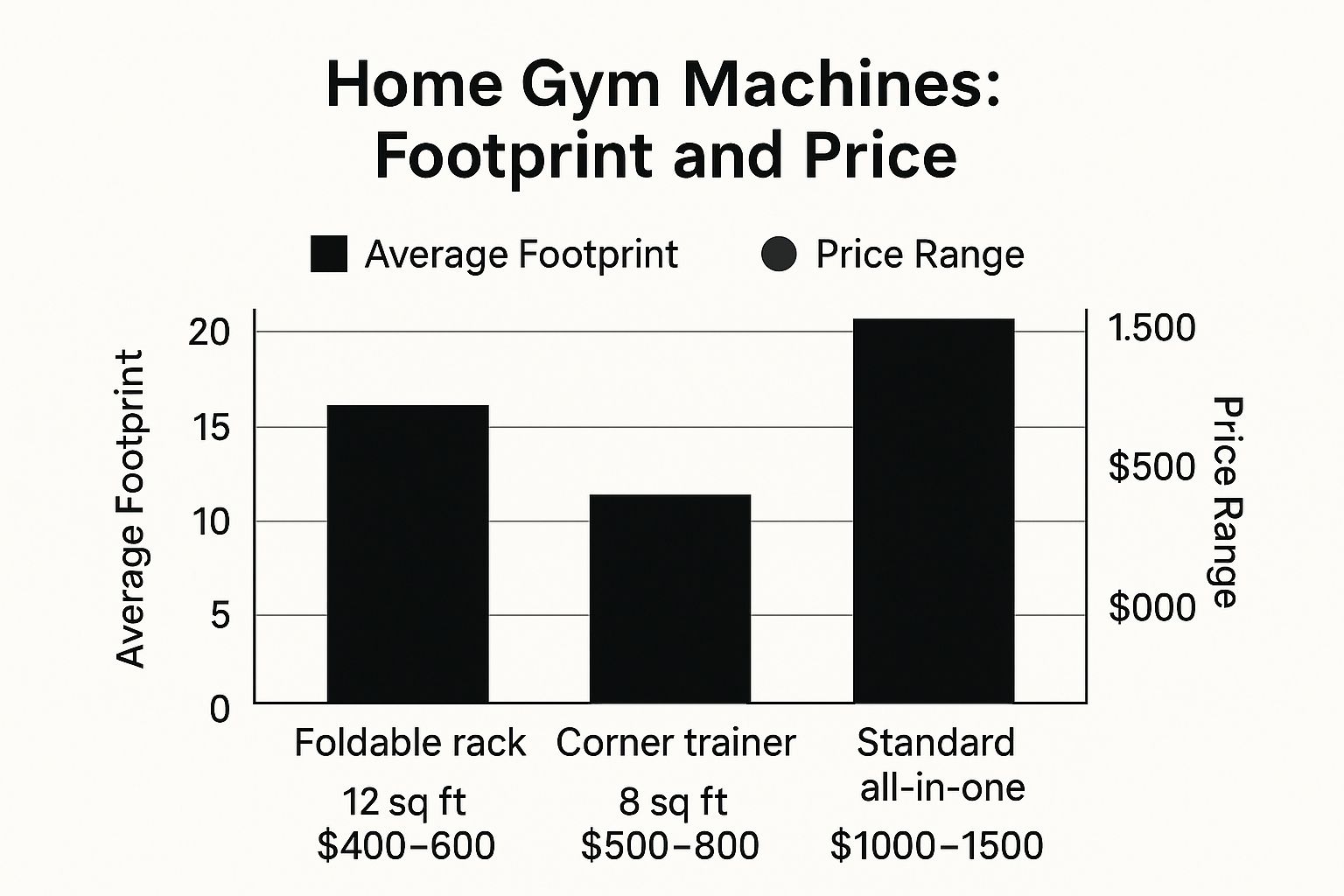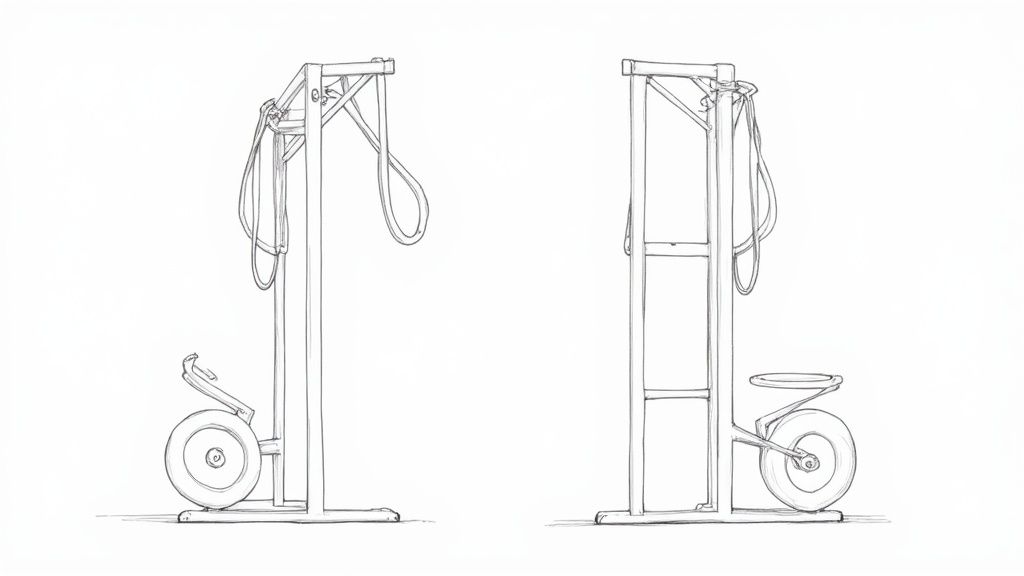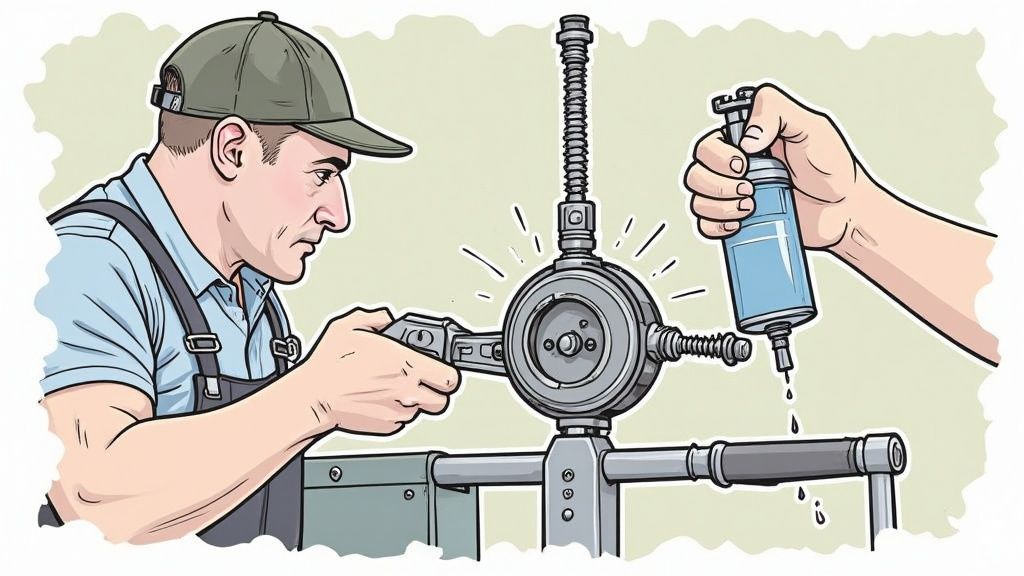Welcome to Bare Fitness. If you're looking into weight machines for home gym setups, you're on the right track to making your fitness routine stick. Our entire philosophy is about getting maximum results with minimal fuss, and that starts with choosing equipment that fits your life, not a commercial gym's.
Your Home Strength Journey Starts Here

This guide is designed to cut through the noise and confusion. We'll focus on what truly matters when picking out a machine that fits your space, goals, and budget. The aim isn't to build a complicated, intimidating gym in your spare room. It’s about finding that one key piece of equipment you'll actually look forward to using.
You're not alone in this shift. The home gym equipment market is booming, expected to hit somewhere between $12.4 billion and $31 billion by 2025. This growth is driven by people just like you who want effective, accessible training at home. You can read more about the home gym market trends to see what's behind this incredible change.
What You'll Learn in This Guide
Our approach is practical and straightforward. We’re here to help you navigate the often-overwhelming world of weight machines for home gym applications by zeroing in on the essentials.
Here’s what we'll cover:
- Pinpointing Your Goals: We’ll show you how to match a machine’s function to what you want to achieve, whether it’s building muscle, toning up, or just getting stronger for everyday life.
- Realistic Space & Budget Planning: You'll get practical tips for measuring your space (don't forget ceiling height!) and finding quality equipment that won't break the bank.
- Key Features vs. Unnecessary Gimmicks: We'll help you spot the difference between essential, high-quality components and flashy extras that just add to the price without adding real value.
- Safe Setup & Simple Maintenance: You’ll get a simple checklist for assembling your machine and keeping it in top shape, ensuring it lasts for years and keeps you safe.
The best weight machine isn't the one with the most features; it's the one that removes the barriers between you and your workout. It should feel empowering, not intimidating.
By the end of this guide, you'll have the confidence to choose a piece of equipment that makes strength training feel totally achievable from day one.
Matching Your Machine to Your Fitness Goals
Before you even look at brands or prices, the most important question to ask yourself is: “What do I really want to accomplish?” The most advanced machine is just an expensive coat rack if it doesn’t help you reach your goals.
Let's get clear on your primary objective. Are you aiming to build significant muscle, get stronger for daily life, or simply tone and sculpt your physique? Each goal points toward a different type of machine.
Building Overall Strength and Muscle
If hypertrophy (the technical term for muscle growth) or major strength gains are your target, your machine needs one non-negotiable feature: the ability for progressive overload. This simply means you must be able to consistently add more weight over time. It's the foundation of getting stronger.
For this, multi-function systems and machines with a solid weight stack are your best bet.
Here’s how that looks in practice:
- For Upper Body Power: Someone focused on building a bigger chest and back might look at a machine with a built-in lat pulldown station. This is fantastic for isolating your back muscles with a stable, guided motion. A functional trainer, with its versatile cables, offers more freedom for exercises like cable crossovers and presses from multiple angles.
- For Lower Body Development: If you want powerful legs but feel intimidated by heavy barbell squats, a solid leg press machine can be a game-changer. It’s a safe and effective way to load up your quads, hamstrings, and glutes without stressing your spine or worrying about balance.
The bottom line: You need a machine that lets you safely challenge your muscles. To grow, you have to push your limits, and the right equipment makes that process accessible and repeatable.
Functional Fitness for Everyday Life
Maybe you're not trying to become a powerlifter. Maybe you just want to carry groceries up the stairs without getting winded, lift your kids without tweaking your back, or improve your posture from sitting at a desk all day. This is where functional fitness comes in.
For this goal, you want equipment that lets you perform multi-joint, compound movements that mimic things you do outside the gym. This is where the most versatile weight machines for home gym setups truly shine.
A functional trainer with dual adjustable pulleys is almost always the best choice here. It's designed for exercises that train your body to work as a single, coordinated unit. You can do movements like:
- Wood Chops: To build rotational core strength used for everything from swinging a golf club to shoveling snow.
- Pallof Presses: An excellent exercise for building a rock-solid core that resists twisting forces, protecting your spine.
- Rows and Pushes: From various angles, mimicking real-life actions like pushing open a heavy door or pulling a lawnmower cord.
This type of training directly translates into making daily life feel easier and reducing the risk of injury.
Toning and Muscular Endurance
If your main goal is to build a lean, defined look and improve your muscular endurance, you can skip the machine with a massive 300 lb weight stack. What you really need is a machine that provides smooth, consistent tension and makes it easy to perform higher-rep sets (think 12-20 reps).
Selectorized (pin-loaded) weight stack machines are brilliant for this. The pin system lets you change the weight in seconds. This is perfect for keeping your heart rate up and rest times short, leading to a very efficient workout.
You can easily perform "drop sets"—where you do a set, immediately lower the weight, and continue with more reps—a classic technique for building that toned look and pushing your endurance. This makes them one of the most practical types of weight machines for home gym owners who are short on time but still want great results.
Finding the Perfect Fit for Your Space and Budget
Now, let's get practical. Most of us are trying to fit a solid workout into a corner of the basement, a spare bedroom, or the garage. This is where the real-world constraints of inches and dollars come into play.
A machine that doesn’t fit your space or budget will quickly become a source of stress, not strength. The good news is that the market is filled with smart, space-saving designs made for exactly this situation.
Measuring Your Workout Zone
Before you even think about buying, grab a tape measure. This is the most crucial first step. You need to think beyond the machine's listed footprint and consider the three-dimensional space required for movement.
- Floor Space (Length x Width): Look at the machine's dimensions, then add at least 2-3 feet of buffer space on every side. This is your safety zone—room to load weights, step back, and perform exercises without hitting a wall.
- Ceiling Height: This is the one everyone forgets. If you’re looking at anything with a pull-up bar or an overhead press, you need enough clearance to perform the full movement without hitting your head. A standard 8-foot ceiling can be tight, so measure twice.
- Movement Space: Visualize yourself using the machine. A cable crossover needs wide-open space in front. A leg extension needs room for your legs to extend fully. Walk through the motions in your head to ensure the space works for your planned exercises.
This infographic gives a quick visual of how different machine types compare in terms of footprint and cost.

As you can see, options like corner trainers are cleverly designed to maximize utility in a small area.
Aligning Price with Value
Once you know what will physically fit, it's time to talk budget. The price of weight machines for home gym setups varies widely, but a higher price tag doesn't automatically mean it's the best machine for you.
Thankfully, the variety in the market works in our favor. The home fitness world has exploded with options, creating competition that results in solid solutions for almost any budget. If you're curious, you can discover more insights about home gym market segmentation and see just how diverse the industry has become.
To help you get a handle on what to expect, here is a quick comparison of common machine types and their typical costs.
Space and Budget Comparison for Home Weight Machines
This table gives you a realistic look at the space you'll need and the money you'll spend for different types of popular home weight machines.
Think of these numbers as a starting point. Your perfect machine is out there; it's just a matter of balancing your space, goals, and budget.
Here’s how we break down the budget tiers:
- Entry-Level ($400 - $800): You can find some surprisingly good foldable racks and basic functional trainers in this range. Focus on the fundamentals: a solid steel frame and a stable base. You’ll give up some extra features, but the core machine should feel secure.
- Mid-Range ($800 - $1,500): This is the sweet spot for most people. Here you’ll find robust all-in-one systems with smoother pulley action, more attachments, and better overall build quality. It’s where versatility and value meet.
- Premium ($1,500+): At this level, you're investing in heavier weight stacks, commercial-grade components, and often lifetime warranties. This is for the person who plans on lifting heavy and consistently for years to come.
A crucial tip: Always factor in shipping costs. For heavy equipment, this can add hundreds of dollars to the final price. And don't overlook the warranty—a long and comprehensive warranty is the best sign that a company stands behind its product. It’s your insurance policy on quality.
What Really Matters in a Weight Machine (And What to Ignore)

When you start shopping for weight machines for home gym setups, it’s easy to get lost in features and marketing hype. Let's cut through the noise and focus on what actually makes a machine a solid investment.
Think of it like buying a car: you wouldn't be impressed by a fancy stereo if the engine was unreliable. The same logic applies here. A digital console and tons of attachments are useless if the machine's core components are poorly made.
The Non-Negotiables: Your Quality Checklist
These are the foundational elements of any good machine. Do not compromise on these three things, regardless of your budget. They are the difference between a great workout and a frustrating (or dangerous) one.
- A Rock-Solid Frame: The frame is the skeleton of the machine. It must be made from heavy-gauge steel. Give it a good push. If it wobbles or feels unstable, walk away. Stability equals safety.
- Smooth, Uninterrupted Pulley Action: Pay close attention to the cables and pulleys. When you pull a handle, the motion should be completely smooth and consistent from start to finish. Any sticking, grinding, or jerking means you won't get constant tension on the muscle—which is the entire point of using a machine.
- Durable Upholstery and Padding: The bench pads, leg rollers, and other contact points should feel firm and supportive, wrapped in thick, tear-resistant vinyl. Cheap, thin padding will flatten and crack quickly, making workouts uncomfortable.
A machine’s real value isn't found in its bells and whistles. It’s in the quality of its steel, the smoothness of its bearings, and the durability of its build. These are the things that will hold up for thousands of reps.
Common Red Flags and Marketing Gimmicks
The home fitness market is massive—the global exercise equipment market was valued at USD 49.81 billion in 2025, driven by a surge in health consciousness. You can read more about the growth in the exercise equipment market on Statista. This popularity means many companies try to sell you on features that don't actually matter.
Here are common pitfalls to avoid:
- Flimsy or Thin Cables: Look for aircraft-grade cables with a protective coating. Uncoated, thin cables are a huge red flag. They can fray and eventually snap under load, which is a major safety hazard.
- Plastic Bushings Instead of Bearings: High-quality machines use sealed bearings in their pulley systems for a smooth feel. Cheaper models use plastic bushings that wear out fast, leading to jerky, uneven movements.
- Gimmicky Attachments: Be wary of machines that boast "100+ exercises!" but rely on flimsy, awkward attachments to hit that number. A machine that does 20 core exercises exceptionally well is far better than one that does 100 poorly.
- Over-the-Top Weight Stacks: Don't be fooled by a machine offering a 300 lb stack if the frame itself feels light and cheap. For most people working out at home, a 150-200 lb stack provides more than enough resistance. A heavy stack on a weak frame is just a marketing trick.
Once you know how to spot these details, you can evaluate any weight machines for home gym with a critical eye and choose one that delivers real performance and value.
Getting Your New Machine Set Up and Running

The big box has arrived! That moment of excitement can quickly turn to dread when you see the pile of parts. But don't worry—assembling and caring for your new machine is the first step in your home gym journey, and it's totally manageable. A little careful work now saves you from major headaches later.
Nailing the Assembly
Unpacking a new weight machine can feel like a grown-up Lego set. The key is to take your time and follow a logical plan. Before you touch a wrench, lay everything out and check each part against the inventory list in the manual. Discovering a missing bolt halfway through is incredibly frustrating.
Here are a few tips to make it easier:
- Use Your Own Tools: The tiny wrench included is usually not great. Grab a real socket set or a good adjustable wrench. Your hands will thank you.
- Do a Final "Double-Tighten": Once you finish a section, go back over every bolt and give it one last turn. Parts can settle as you add more pieces, and this helps prevent wobbles.
- Get a Friend to Help: Even if you can lift the parts, having a second person to hold things in place is a game-changer. It makes the process faster, safer, and less awkward.
Where to Put It: Placement is Key
The spot you choose for your weight machines for home gym can make or break your workout experience. Don't just cram it into any free corner. You need to create a functional workout zone.
Ensure you have at least 2-3 feet of open space around any moving parts. This isn't just about feeling cramped; it's a safety essential. You need a full range of motion to perform exercises correctly without hitting a wall. A thick rubber mat underneath is also a great idea to protect your floors and dampen noise.
Your machine is an investment in your health. Proactive care protects that investment. A few minutes of simple maintenance each month keeps your workouts safe and your gear in top shape.
Your Quick-and-Easy Maintenance Routine
Your machine doesn't need to be babied, but it does require some basic attention to keep it operating smoothly and safely for years. Set a recurring calendar reminder for the first of every month. It only takes about 10 minutes.
Here’s your monthly checklist:
- Inspect All Cables and Straps: Look closely for any signs of fraying, cracking, or wear, especially where they connect to pulleys or handles. A worn cable is a safety risk—replace it immediately.
- Check and Tighten Hardware: Vibrations from regular use can loosen bolts over time. Grab your wrench and give the main structural bolts a quick check to ensure they’re snug.
- Wipe Everything Down: Sweat and dust can be corrosive. Use a simple cleaner to wipe down pads, grips, and the frame. This prevents rust and keeps your setup clean.
This simple habit ensures your machine is always ready for your next workout.
Common Questions About Home Weight Machines
Jumping into the world of home gyms can feel overwhelming. At Bare Fitness, we get it. You want to be sure you're picking the right gear for your goals. To help you feel more confident, we've answered some of the questions we hear all the time.
Are All-In-One Home Gyms as Good as Free Weights?
This is a common question, and the honest answer is that they are different tools for different jobs. One isn't necessarily "better"—it depends on your goals and preferences.
All-In-One Machines: These are fantastic for safety and for guiding your movements. The machine controls the path of the exercise, which makes it much harder to use bad form. This is a huge benefit for beginners or anyone working out alone. They are also brilliant for isolating specific muscle groups with precision.
Free Weights (Dumbbells/Barbells): Free weights are the gold standard for building functional, real-world strength. Because you have to control the entire movement, you automatically engage smaller stabilizing muscles and your core. The trade-off is that they require a good understanding of proper form to use safely.
Think of it this way: a machine is like a high-end meal kit—it gives you all the components and a clear path to a great result. Free weights are like a fully stocked kitchen—the potential is limitless, but you need more skill to get started.
How Much Weight Do I Actually Need?
It's easy to get fixated on the numbers on the weight stack, thinking more is always better. For most people, that’s simply not true.
Unless you're a competitive powerlifter, a machine with a 150-200 lb weight stack is more than enough to build significant strength and muscle. The key to progress isn't lifting the heaviest weight possible; it's performing exercises with good form and consistent tension.
Focus on the quality of the machine's movement, not the size of its weight stack. A smooth, well-built machine with a modest stack will deliver better workouts than a flimsy one that can hold 300 lbs.
Can I Get a Full-Body Workout from One Machine?
Absolutely. In fact, that's the primary benefit of many modern weight machines for home gym setups. You don't need a basement full of equipment to work every major muscle group.
A high-quality functional trainer or a well-designed all-in-one system with different stations—like a lat pulldown, chest press, and leg extension—is a complete workout in a box. These machines are built for versatility, allowing you to perform dozens of exercises that target your back, chest, shoulders, arms, legs, and core.
One smart purchase can give you everything you need for a comprehensive strength routine, right in the comfort of your home.
Ready to simplify your fitness routine with practical, no-nonsense advice? At Bare Fitness, we provide the guidance you need to achieve your goals with minimal equipment and maximum results. Start your journey with us today!



















